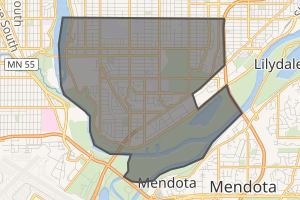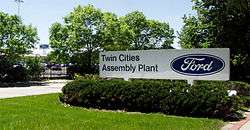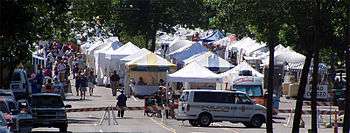Highland Park, Saint Paul
Highland Park is a neighborhood in the southwestern corner of Saint Paul, Minnesota, United States. Also known as Highland District Council (District 15), it lies along the Mississippi River just north of Fort Snelling and across the river from Minneapolis–Saint Paul International Airport. According to the 2000 census Highland Park had a population of 23,202.
Highland Park | |
|---|---|
 The old Highland Park Water Tower, listed on the National Register of Historic Places. | |

| |
| Country | United States |
| State | Minnesota |
| County | Ramsey |
| City | Saint Paul |
| Area | |
| • Total | 6.038 sq mi (15.64 km2) |
| Population (2010)[2] | |
| • Total | 24,589 |
| • Density | 4,100/sq mi (1,600/km2) |
| Time zone | UTC-6 (CST) |
| • Summer (DST) | UTC-5 (CDT) |
| ZIP code | 55116 |
| Area code(s) | 651 |
| Website | http://www.highlanddistrictcouncil.org/ |
Government
The Highland District Council is one of seventeen neighborhood district councils in Saint Paul. The district councils were formed in 1975 to advise the Saint Paul City Council on issues related to the development of its area as well as city and state issues. The HDC Board of Directors is composed of community volunteers elected to serve two-year terms.
History
A veteran of the Mexican–American War, William Finn was the first white person to settle in Highland Park permanently in 1848. He was granted a large portion of land along the Mississippi River and built a house on the land that the University of St. Thomas now occupies. During this time, much of the Highland Park area was encompassed by the Fort Snelling reservation but by the mid 1850s the government opened up most of that land for sale. Growth in the area had pressured the government into making this move and in 1854, approximately 5,000 acres (20 km2) were sold at about $1.25 per acre. This sale opened up the area for settlement, and the area in Ramsey County that was first settled became the last in Saint Paul to be densely populated.[3]

From 1925 to 2011, the Ford Motor Company opened the Twin Cities Assembly Plant (originally for Model T automobiles) in Highland Park and caused much of the remaining farm land in the area to be subdivided for the auto workers. Soon after, in 1927, the Intercity Bridge was built to carry workers over the river from Minneapolis to work in the plant. Construction started in 1927 on the Highland Park Water Tower, a structure that still stands today and has become a landmark on the highest part of Saint Paul.
Following World War II Highland Park experienced another population boom, a large number of new houses were built, the Highland Village Shopping Center was expanded and the Sibley Plaza Shopping Center was finished.[3]
Community

Highland Park currently is a mix of well maintained older housing, commercial and retail property and light industrial buildings. The Ford Plant is no longer open, and announced on April 13, 2006 that the Twin Cities plant would close in 2008, along with the Norfolk, Virginia Ford F-series pickup plant. Ford later reached an agreement with the United Auto Workers which would keep the plant open until 2009.[4] In September 2017, the St. Paul City Council approved a master plan and zoning designed to redevelop the 122-acre (49 ha) site and add as many as 4,000 new housing units.[5][6]
As of August 2017, talks of developing the area near the Highland Park Water Tower have been circulating.[7]
Highland Park became the city's primary Jewish neighborhood after most of the Jewish population moved from the Summit-University neighborhood in the mid-1900s, and it is home to most of the city's synagogues.[8]
Highland Park is served locally by the Villager newspaper which has a subscription base of 65,000.[9] The Highland Park Business Association in cooperation with local community volunteers presents Highland Fest, in the Highland Village, an annual festival that features music, carnival rides, an art fair and fireworks.
The neighborhood is also home to Highland Park Senior High School.
References
- "Highland neighborhood in Saint Paul, Minnesota (MN) detailed profile". City-Data. 2013. Retrieved 2017-03-08.
- "Saint Paul Neighborhood Profile: Highland". Minnesota Compass. October 2011. Retrieved 2017-03-08.
- "History of Highland Park". Ramsey County Historical Society. Archived from the original on 2007-09-27. Retrieved 2007-12-01.
- Jane McClure (Nov–Dec 2007). "Ford plant losing gets put off another year". Villager. 55 (18): 1–3.
- Frederick Melo. "St. Paul council approves sweeping plan to redevelop former Ford plant". St. Paul Pioneer Press. Retrieved 2017-09-28.
- "Ryan Cos. to develop massive Ford site in St. Paul". Star Tribune. Retrieved 2018-06-25.
- "St. Paul: Development proposals sought for 4 acres of land by Highland Park water tower". Twin Cities. 2017-08-24. Retrieved 2017-09-14.
- Marilyn Chiat and Chester Proshan. "We Rolled Up Our Sleeves". Upper Midwest Jewish Archives. Retrieved 2007-12-01.
- "Villager". Minnesota Newspapers Directory. Archived from the original on 2007-10-13. Retrieved 2007-11-05.